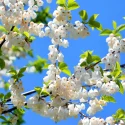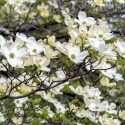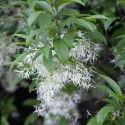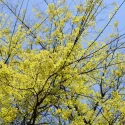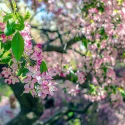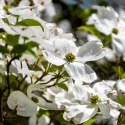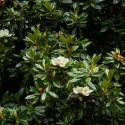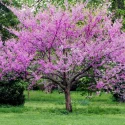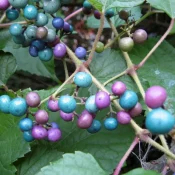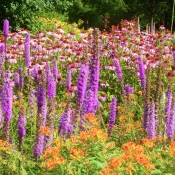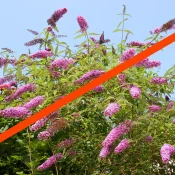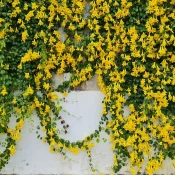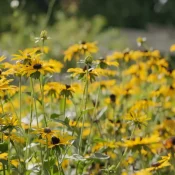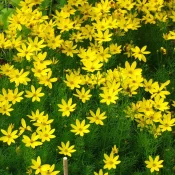Franklin Tree
This is a rare and special tree, and an excellent example of the jaw-dropping beauty of North American native plants. Franklin trees were spotted in the wild in the 1700s and have never been seen in nature again. We have Franklin trees today because the early American botanists who found the tree 300 years ago thankfully grabbed some seeds. Every single Franklin tree can be traced back to that fateful encounter. Plant one (or a few!) and bring your landscape within one degree of separation from early American history.
- Full Sun, Part Sun
- Small Tree (15-30')
- Summer flowers, Fall flowers
- Amazing fall color
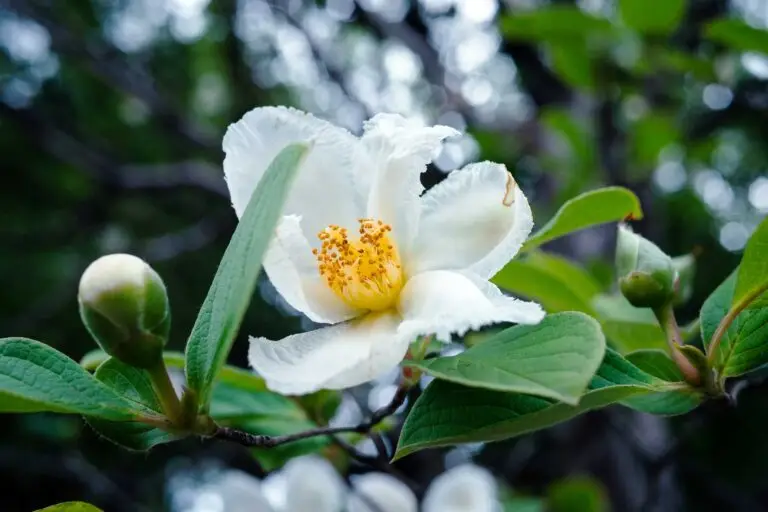
Franklin Trees were once VERY rare—they are now extinct in nature
The story behind the Franklin tree is similar to those about secret pirate treasure, or a mythical lost city. 300 years ago, early American botanists discovered this tree while exploring forests in Georgia.
One of them had the good sense to go back for seeds. Which is good—because the tree has never been seen in the wild since.
In her excellent book, Easy Care Native Plants, writer and native plant lover Patricia A. Taylor writes:
“Franklin tree (Franklinia alatamaha) is perhaps the most extreme example of a plant existing in one specific locality. It was found growing in Georgia in 1765 by the Philadelphia botanist John Bartram and his son, William. Had William not returned later to collect seed and introduce it to ornamental gardens it would have disappeared, because this lovely tree, with its glossy leaves and lustrous white summer flowers, has never been found again in the wild.”
Because all Franklin trees come from this single source, “the current genetic base of this plant is quite narrow in large part because all plants currently in existence in the world come from the materials collected by the Bartrams.” (Source: Missouri Botanic Garden)
In other words: every single Franklin tree can tie its existence back to William Bartram’s hand-picked seeds from the 1700s. It’s an extraordinary connection to early American history if you think about it!
Why is it called a ‘Franklin tree’?
John Bartram named the plant after his close friend and fellow Philadelphian: Benjamin Franklin.
Its Latin name—Franklinia Alatamaha—combines all this history. Franklinia refers to Ben Franklin, and Alatamaha is the name of the river in Georgia where they spotted it.
Now that we’ve covered the history, let’s talk about how to plant them.
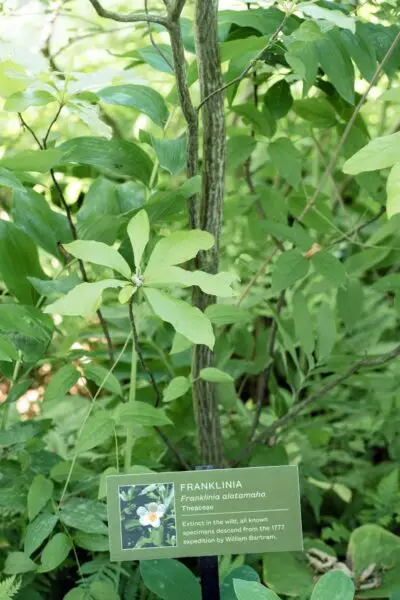
Franklin trees can be tricky to grow—IF they are not planted in their favorite environment
Franklin trees thrive in specific conditions, preferring consistently moist, well-drained areas with loamy soil rich in organic matter. This environment closely resembles their natural habitat along Georgia’s Altamaha River.
Sometimes, landscapers and gardeners can be dissuaded from planting Franklin trees, because they are said to be ‘challenging.’ The Plant Native wants to reset this fear!
Do NOT be scared to plant a native Franklin tree
Remember: native plants have planted themselves—with no human intervention—for millions of years. They don’t need fancy irrigation systems or imported fertilizer. All you need to do is mimic nature for native trees like the Franklin tree to thrive in your landscape or yard.
You can successfully plant a Franklin tree by picking the right spot and paying attention to soil and water. Make sure the spot is:
- Consistently moist. This can mean being regularly watered (via a hose or irrigation) or an area that’s near a natural water source—like a stream, pond, or lake.
- Well-drained. I know, you’re thinking—”wait, didn’t you just say Franklin trees like water?” And they do—they just don’t like sitting in it for days on end. Well-draining spots can include hills, or ensuring that the soil nearby has ways for water to dissipate (French drains count, too!)
- Loamy, rich soil. Loam is a gardening term for soil that has organic matter in it. You can tell if the soil is loamy if it’s dark brown/black. If your soil is more light brown due to clay or sand, you’ll need to add compost, humus, and perhaps peat (or peat alternatives) to make sure your Franklin tree is happy.
- Acidic soil. In nature, the most common reason for acidic soil is pine trees. When the needles drop and decompose in the soil, they make the soil acidic. In our modern times, you can just add acidic fertilizer or add other acidic nutrients.
Or, you can take a great tip from master gardener Carolyn Harstad, and fertilize your Franklin tree with the branches from your Christmas tree! Yep, just cut the branches off and lay them around the Franklin tree to mimic nature.
The University of Maryland Extension Home and Garden Information Center (UMDHGIC) has a great overview video filled with planting tips:
When do Franklin trees bloom?
Franklin trees bloom in mid-July or August and keep blooming until the fall. (This is a big difference between other flowering trees like native dogwoods or redbuds, which bloom for 2-4 weeks.) This flowering time is true when it’s planted in Midwest, Southern, Mid-Atlantic, and Northeast gardens.
Once they start blooming, they bloom for a long time—4-6 weeks of flowers, on average. Some gardeners say they keep blooming into the fall, especially on mature trees.
Where should I plant a Franklin tree?
Franklin trees are perfect statement trees, very useful for front yards or as garden anchors. They are great for front yards because they don’t get too tall—normally topping out around 20 feet—so they don’t block houses.
Again—having a well-drained spot is important. This is one reason why hills are great spots to plant Franklin trees.
What do Franklin trees look like in the fall and winter?
Franklin trees’ leaves turn bright reddish in the fall before falling to reveal gray, sculptural branches. According to master gardener Carolyn Harstad in her excellent book, Go Native!, “It has fiery orange-red fall foliage, and interesting gray bark.”
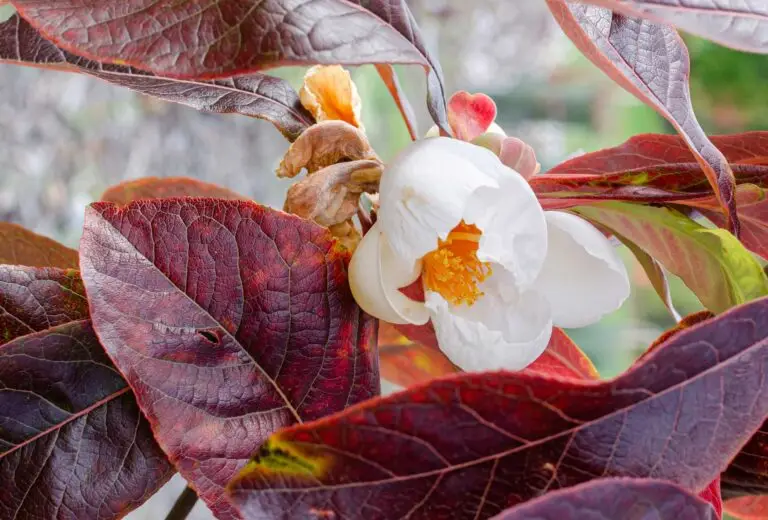
Do Franklin tree flowers have a smell?
Yes! Franklin tree flowers have a light, sweet fragrance when in bloom.
What a special plant! And now you are asking…
Where can I buy a Franklin Tree?
We’re not going to lie to you—this plant may take a little bit of work to find. But it’s so worth it. To help you find one quickly, here are four ways to source a Franklin Tree in your area:
Where can I find seeds and plants?
Finding native plants can be challenging (we partly blame Marie Antoinette.) To make it easier, we’ve assembled four sourcing ideas.
Native Nursery List
300+ native nurseries makes finding one a breeze
Online Native Plant Sellers
We've included 100+ online resources to help
Society Plant Sales
Every state has a native plant society; find yours
Online Communities
Local Facebook groups are a great plant source
What are good pairings for Franklin trees?
Franklin trees do wonderfully alongside other native shrubs and flowers that thrive in a similar environment—well-drained, consistently moist, loamy soil that’s acidic. Some great pairings include:
To sum it all up and paraphrase native plant guru Carolyn Harstad—
Franklin Trees are living proof that a single person can make a difference in our natural world. Without John Bartram’s act hundreds of years ago, we would be without this tree. Our actions in the garden have power and are a delight to our landscapes.
Franklin trees are incredible native trees perfect for high-profile landscaping (included in our Best Native Trees for Front Yards round-up.) Their four-season beauty offers glossy green leaves in the spring, creamy flowers in the late summer into fall, and gorgeous fiery-colored fall foilage as the temperatures drop. Don’t be dissuaded by its reputation for being finicky and challenging to grow. With careful planning of the spot you pick, extra water during dry times, and some potential soil amending, you can grow this tree and enjoy its beauty for decades. They are a beautiful tree for Mid-Atlantic, Midwest, or Southern gardens. Happy planting!
Sources
- Nelson, Gil. Best Native Plants for Southern Gardens: A Handbook for Gardeners, Homeowners, and Professionals, (2010).
- Harstad, Carolyn. Got Sun? 200 Best Native Plants for Your Garden. (2013), 6.
- Missouri Botanical Garden, “Franklinia Alatamaha-Plant Finder,” n.d. https://www.missouribotanicalgarden.org/PlantFinder/PlantFinderDetails.aspx?kempercode=q160.






